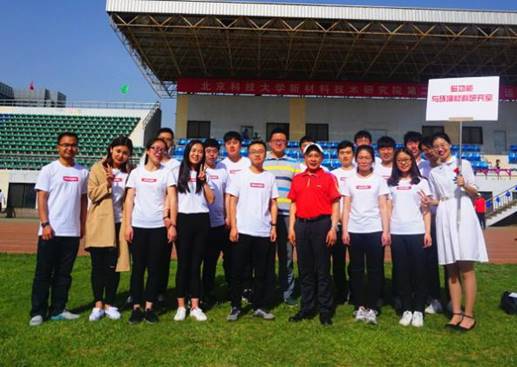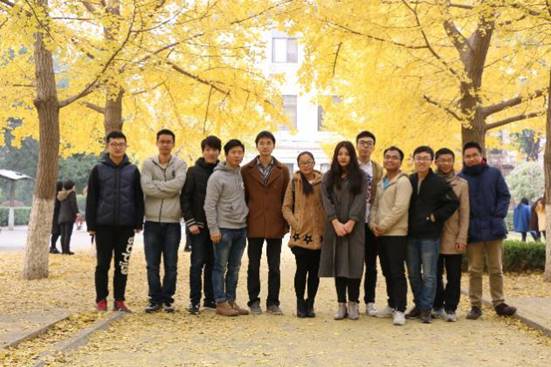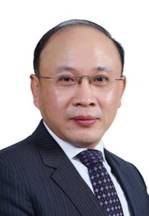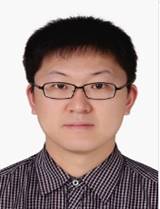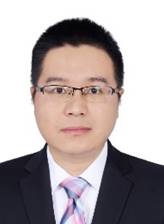Department of Functional Materials
Laboratory of Functional Magnetic and Environmental Materials
【Laboratory of Functional Magnetic and Environmental Materials】
Functional Magnetic and Environmental Materials Laboratory engages in the studies of functional materials and devices, materials recycling technologies. The Group firmly keep in mind that research serves national economy and national defense, and strengthen both basic and applied researches. We focus on the national demand-oriented industry-study-research cooperation and carry out over 30 research projects. The achievements have been awarded more than 10 prizes of national and provincial levels, of which many are applied in industry and national defense. We have formed an open, practical, cooperative, innovative, and people-oriented academic atmosphere.
【Lab members】
|
|
|
|
Shengen Zhang |
Bo Liu |
Xiaoyan Zhang |
Yunji Ding |
Shengen Zhang Ph.D., Professor, Group leader, Deputy dean
Bo Liu Ph.D., Assistant research fellow
Xiaoyan Zhang Ph.D., associate professor
Yunji Ding Ph.D., Postdoctoral
【The main research fields and achievements】
1. Recycling, utilization and harmless disposal of waste electrical and electronic equipment
The amount of waste electrical and electronic equipment (WEEE) is huge and growing rapidly. It has become important “urban mining” since it contains large amounts of critical metals. The recycling technology of WEEE is a prominent mission of the world due to their complex components, high-graded of valuable metals and toxic materials. Herein, the complete non-cyanogens wet process for green and economic recycling of gold, silver, and palladium have been developed, as well as heavy metals extraction technology and equipment for the recovery of copper, lead, thin, and nickel. High-graded alloy electrolysis technology and equipment have been studied and achieved extraction of pure metals at a constant voltage with multiple steps. Moreover, technology and equipment have been also developed to avoid the pollutions of cyanide, heavy metals, freon, residual oil, dust, and dioxins. The achievements have been awarded the second price of National Technology Invention, first prize of Beijing Science and Technology Award, first prize of Chinese Nonferrous Metal Industrial Science and Technology Award, China Patent Excellence Award, and second prize Beijing Invention Patent Award.


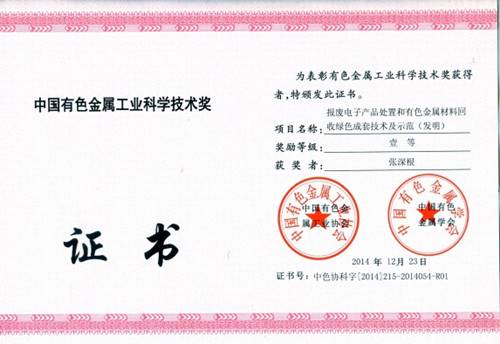
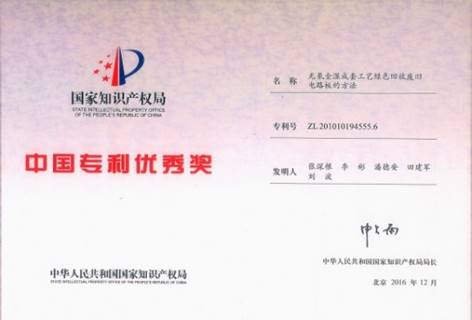

Certificates of achieved awards
2. “Can to Can” technology
In China, there are around 700, 000 tons (33 billion units) of aluminum cans scrap annually. These scrap aluminum cans are coated with epoxy resin and paint or other organic matters on inner and outer surfaces, and contain large amounts of non-aluminum impurities and beverage residue. Moreover, the compositions of tank, lid and ring are totally varied, and they cannot be separated on the industrial scale. The traditional “direct smelting - degradation” process are demoted to produce low-grade aluminum alloys for construction or metallurgical reductants due to above reasons, causing serious environmental pollution as well.
In order to realize “can to can” technology, we studied the low oxygen dynamic thermal de-coating technology and rotary dynamic coating removal kiln. Over 95% of the coating were removed, which significantly reduced the potential generation of dioxins. The regenerative double chamber furnace and smelting technology were developed and realized 97% recovery efficiency of aluminum.
The energy consumption of smelting can be reduced to 58 m3 gas (about 567 kWh/t), which accounts for only 3.78% of primary aluminum energy consumption. Additionally, online detection of aluminum alloy composition and adjustment technology were also developed. To obtain high purity aluminum alloy for cans that meet requirements of GB/T3190-2008, Al-Ti-B-RE compound modifier and refining process were investigated. This research were awarded the First and Second Prizes of Science and Technology by China Non-ferrous Metals Industry Association.
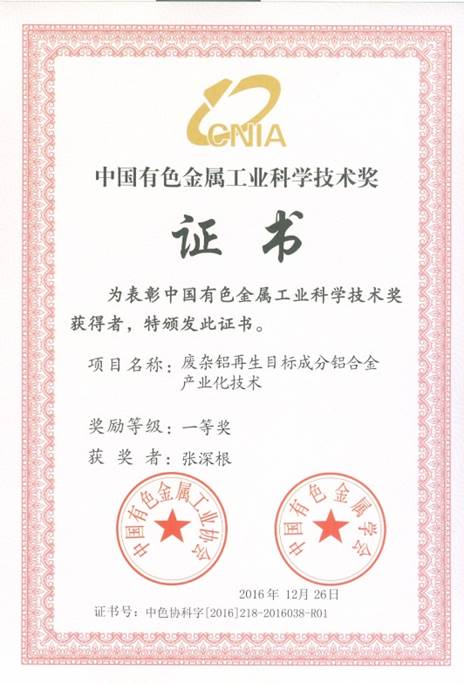
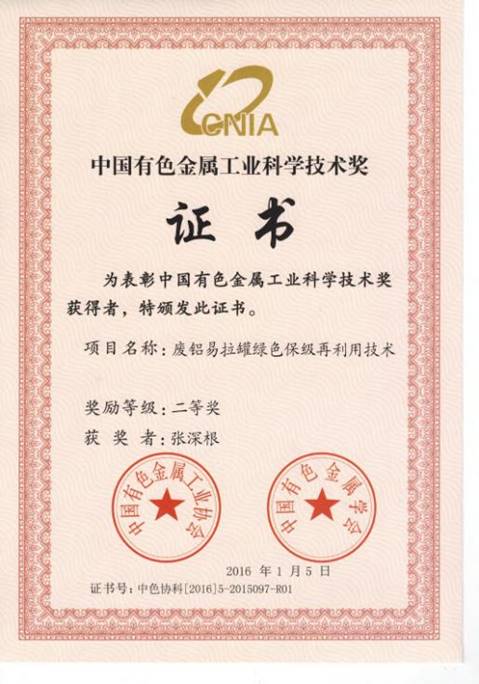
Certificates of achieved awards
3. Scrap Aircraft Aluminum Alloy Recycling Technology
According to the international Aircraft Fleet Recycling Association (AFRA), more than 12,000 aircraft will be retired worldwide over the next 20 years. Aluminum alloys account for appropriate 70 wt.% of scrap aircraft, which has remarkable economic benefits. However, currently most of the scrap aircraft aluminum alloy is degraded by direct re-melting and used for low-grade casting aluminum alloy. This technology reduced their economic value and caused serious environmental pollution. To solve the above issues, key technologies such as online measurement and adjustment of alloy melt composition, removal of impurity elements, melt degassing, refining and homogenization treatments have been developed. The 2024 and 7075 aluminum alloys have been recovered from scrap aircraft, and the properties of recovered aluminum alloys meet the requirements of GB/T3190-2008.
4. Green technology of recycling precious metals
Due to limited reserves, widely application and strategy significance, precious metals have been honored as “modern industrial vitamin”. By using copper, lead, or nickel as trapping agents to collect precious metals from spent catalysts, these traditional pyrometallurgical methods have raised serious heavy metals pollution. Hence, the occurrence state of precious metals and the laws of their valence variation have been intensively investigated. The reduction thermodynamics and kinetic model of precious metal compounds were established to increase their recovery rate. We clarified the relationship between the carriers of spent catalysts and slag design, and optimized the composition of slag, and finally realized the deep separation of slag and iron. With the aim of optimizing reaction system, we figured out the chemical reactions in complex system, and then revealed the coupling relationship of multiphase reaction. In order to decrease the content of precious metals in slag, migration trajectories of precious metals were described, and the distribution model of precious metals in slag were established. The results of this study provides theoretical basis and application foundation for green and efficient collection precious metals by iron from spent catalysts. It can not only completely put an end to the pollution of heavy metals, but also ensure the supply security of precious metals in China. The results generate significant social, economic and environmental benefits. The results have been awarded first prize of “Scientific Paper of The Nonferrous Metals Society of China”.

Certificates of achieved awards
5. The mechanism and production of glass-ceramics using Cr-containing solid waste
The traditional landfilling or cement solidification of Cr-containing solid waste have raised serious heavy metal pollution. Hence, the solidification and detoxification mechanism of Cr and Ni and the application of glass-ceramics were systematically studied. The redox reactions of Cr6+ detoxification mechanism has been clarified, and the stable phase regions of Cr3+, Cr6+, Ni2+ and their compounds have been determined. The principle of composition allocation of diopside glass-ceramics have been determined. We proposed the amorphous nucleation and solid-state phase nucleation and clarified the existing forms and curing mechanism of Cr, Ni, Pb and Cd in glass-ceramics. The glass-ceramics prepared from Cr-containing waste have excellent comprehensive properties.
Recently, we are devoted to promoting the application of glass-ceramics prepared from Cr-containing waste with Jingniu Co., Ltd., and negotiate the PPP popularized models with relevant departments in Beijing, Tianjin and Hebei.
6. Alkaline fusion recovery of rare earth elements from waste phosphor and its mechanism
Waste phosphor contain valuable heavy rare earth elements (REEs) Eu and Tb. However, REEs recovery efficiencies are extremely low due to stable crystal structure of Green (Ce0.67Tb0.33MgAl11O19) and Blue (Ba0.9Eu0.1MgAl10O17) phosphors that cannot be dissolved in acid and alkali. Acid leaching- alkali sintering and leaching process have been developed, and the disintegration of Ce0.67Tb0.33MgAl11O19 and Ba0.9Eu0.1MgAl10O17 via alkaline fusion was also illuminated. The total recovery efficiency of REEs was over 90%, where Y and Eu are more than 95%, Ce and Tb are more than 70%. This technology have been industrialized, improved the value of waste rare earth luminescent materials. The achievements won the first prize “Scientific Paper of The Nonferrous Metals Society of China”.
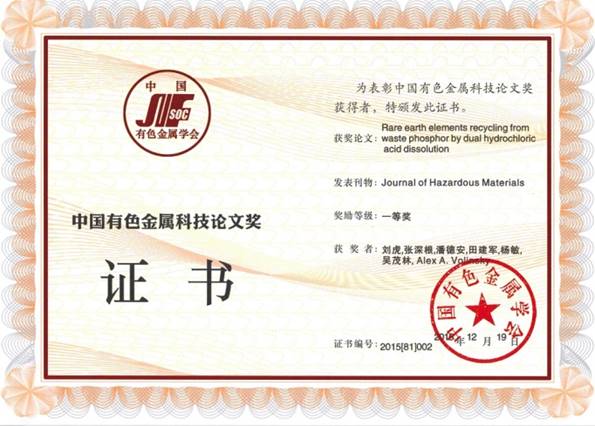
Certificates of achieved awards
7. Utilization of oily cold milling sludge and grinding scraps
In China, more than 100, 000 tons of oily cold rolling mill (CRM) sludge and grinding scraps are produced each year. However, oily CRM sludge and grinding scraps are mainly reused as raw materials in the smelting furnaces or even stockpiling, which caused serious environmental pollution and reduced their economic value. Hence, we developed the technology and the equipment for deoiling from oily CRM, which can realize the following functions: controllable oxygen partial pressure, automatic temperature control, rotating deoiling, oil vapor recovery via condensation, offgas collection. Using the oily CRM sludge as raw materials, a variety of high value-added products have been developed, such as reduced iron powder (YB/T 5308-2011), high performance strontium ferrite powders (exceeded Y30 product index), first-class goods of micaceous iron oxide pigments for paints (ISO 10601-2007).
8. Radiation oriented rare earth permanent magnet ring and multi-pole ring production
Using self-developed magnetic field injection molding and magnetic field compression molding technology, a highly efficient method for preparing rare earth permanent magnet ring overall radiation orientation has been established. The high-precision radial magnetic ring and multi-pole have been prepared by using vacuum calcined surface of the magnet to form a ductile metal layer to reduce cracking of radial magnetic ring. The prepared rare earth permanent magnet rings are used in gyroscopes and motors. The achievements are awarded the second prize of Science and Technology in Guangdong province, third prize and the first prize of Science and Technology in Zhaoqing City, and second prize of China Nonferrous Metals Industry Science and Technology.
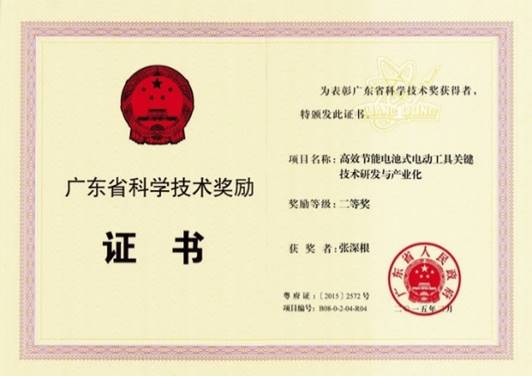
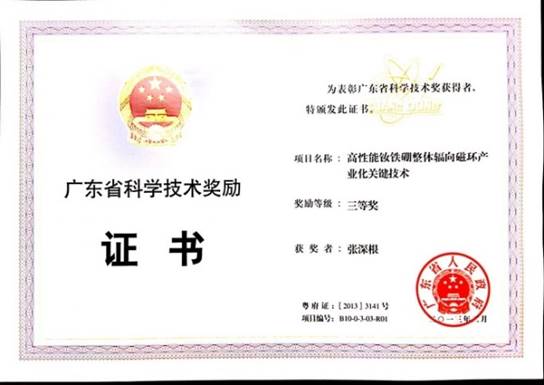

Certificates of achieved awards
Projects and Fundings
1. “Made in China 2015” Green Manufacturing System Integration Project: Systematic integration of green key technology on recovery and further processing of precious metals from typical waste
2. Key Program of National Natural Science Foundation of China (U 1360202): Mechanism on the solidification and detoxification of Cr, Ni and application of glass-ceramic
3. National Natural Science Foundation of China (51672024): Detoxification Mechanism of Pyrolysis of Dioxins and Cl Mobilization for MSWI Fly Ash
4. National Natural Science Foundation of China (51472030): Study on Resolution Mechanism of Crystal Structures for Green and Blue Rare Earth Phosphors in Alkali Fusion
5. National Natural Science Foundation of China (51174247): The Mechanism on preparation of soft magnetic composite material by cold roll grinding of iron and steel
6. National Natural Science Foundation of China (51004011): The Mechanism of reduction of polyol of SmCo5 nanoparticles for ultra-high density magnetic recording
7. National Natural Science Foundation of China (50972013): Synthesis Mechanism of Superparamagnetic Nano-Fe3O4 Particle via Combustion-carbon Thermal Reduction at Low Temperature
8. National Natural Science Foundation of China (50874010): Magnetic-thermal-machine Coupling Model for Bonding Terfenol-D Composites<110>Texture and Density
9. National High Technology Research and Development Program (2012AA063202): Technologies and equipment on rapid identification of rare earth fluorescent and recycling of luminescent materials
10. National Key Technology Research and Development Program of the Ministry of Science and Technology of China (2011BAE13B07): Research on the utilization of waste generated during strip steel cleaning and cold rolling process
11. 11. National Key Technology Research and Development Program of the Ministry of Science and Technology of China (2011BAC10B02): Research on “can to can” technology and its application
12. National Key Technology Research and Development Program of the Ministry of Science and Technology of China (2012BAC02B01): Preparation of glass-ceramic using Cr-containing steel slag
13. National Key Technology Research and Development Program of the Ministry of Science and Technology of China (2009BAE74B03): Industrial development of high-performance soft magnetic composite material (SMC) and environment-friendly magnetic core
14. National Development and Reform Commission Special Project on New Materials Research and Industrialization of Rare Earth and Rare Metals: Key technology research on the ultra-fine grain cemented carbide and CNC coated blade and its industrialization
15. Program for New Century Excellent Talents in University of Ministry of Education of China (NCET-05-0101): Study on bonding rare earth giant magnetostrictive materials
16. The National R&D Infrastructure and Facility Development Program of China (2005DKA32800): Information and Materials Data Sharing Node Planning and Framework Construction
17. Special Project on the Integration of Industry, Education and Research of Guangdong Province (2009A090100017): Research on the technology, equipment and industrialization of environment-friendly recycling and further processing of waste printed circuit boards
18. Special Project on the Integration of Industry, Education and Research of Guangdong Province (2010A090200080): Research of the industrialization of energy efficient motor with anisotropic bonding NdFeB permanent magnet device
19. Special Project on the Integration of Industry, Education and Research of Guangdong Province (2010A090200061): Research and development of critical materials and battery power management systems for high-current, high-power density power storage batteries
20. Special Project on the Integration of Industry, Education and Research of Guangdong Province (2009B090300443): Study on iron-based soft magnetic composite materials for small and medium motor with high efficiency
21. Special Project on the Integration of Industry, Education and Research of Guangdong Province (2008B090500036): Key technology of high performance temperature sensitive ferrite powder injection molding and its industrialization
22. Special Project on the Integration of Industry, Education and Research of Guangdong Province (2007B090400108): Key technology for the industrialization of overall high-performance NdFeB radial magnetic ring
23. The Boeing Company (2019-GT-119): 7050 Aluminum Alloys Recycling at Pilot
24. The Boeing Company (2017-GT-198): 7075 aluminum alloy recycling from aircraft aluminum scraps
25. The Boeing Company (2016-401): Aero Al recycling through metallurgical process
【Graduates】
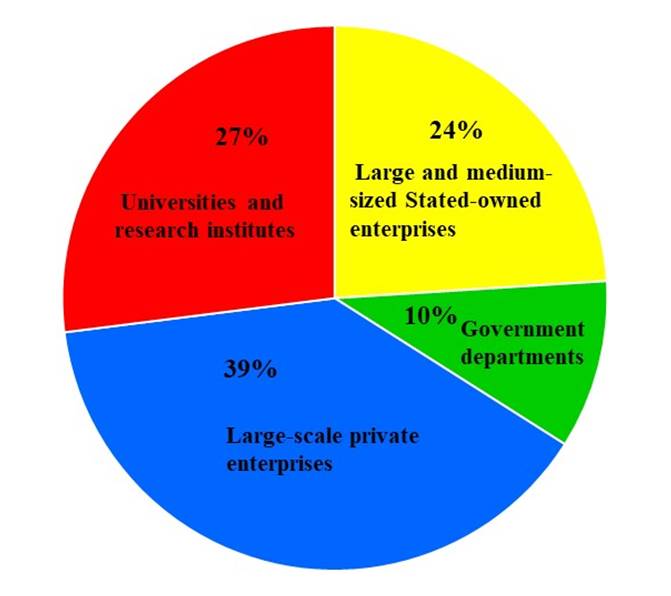
The employment distribution of graduated students
As of July 2019, 50 students graduated from the laboratory. Among them:
1) 14 alumni such as Bo Liu, Ping Hu, Bin Li, Hu Liu, Yifan Liu, and Yunji Ding have been working at research institutes and universities as researchers or managers, such as University of Science of Technology Beijing, Xi'an University of Architecture and Technology, Beijing University of Technology, Nanchang University, Taiyuan University of Technology, Beijing General Research Institute of Mining and Metallurgy, Beijing Building Material Academy.
2) 13 alumni such as Jian Wang, Chunfu Kuang, Jian Yang have been working at state enterprises as researchers or managers, such as Baosteel Cooperation, Panzhihua Iron and Steel Company, Xiamen Tungsten Company, Sinosteel Corporation.
3) 18 alumni such as Youping Miao, Jing Zhang have been working at large-scale enterprises such as GEM Group, Lizhong Group, BOE Technology Group.
4) 6 alumni including Duanjing Zhang, Longsen Zhang, Fuzheng Yin have been working at government departments such as China National Intellectual Property Administration, General Administration of Quality Supervision of Beijing, Tianjin Institute of Scientific and Technical Information.
Team construction

Hydrometallurgy laboratory
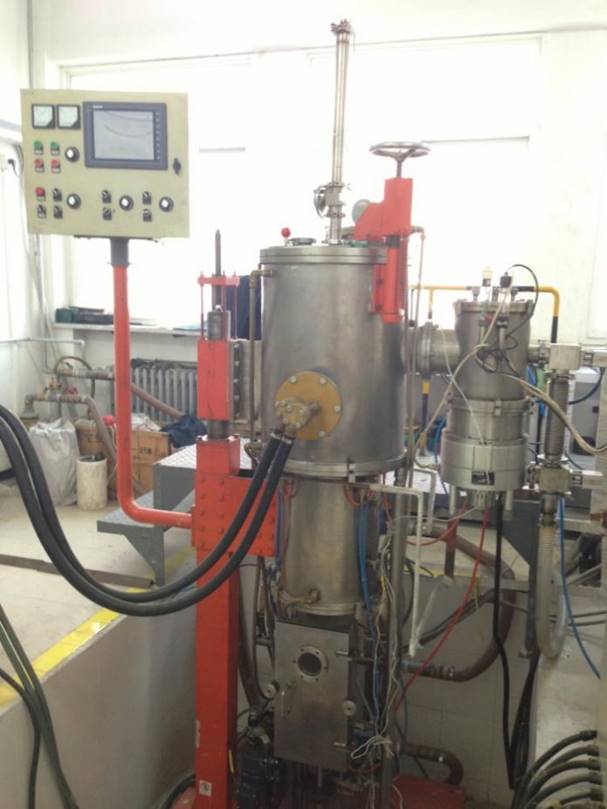
One-step vacuum directional freezing equipment
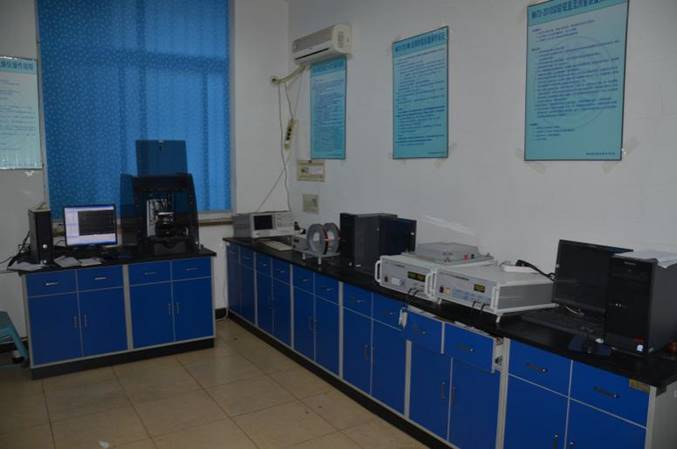
Materials Testing Laboratory
We are always rigorous, positive, and cooperative. On the road of exploring, the laboratory completed a number of national, provincial research programs. Everyone in the lab is youthful, helpful, and we have a rich diversity of leisure activities.
